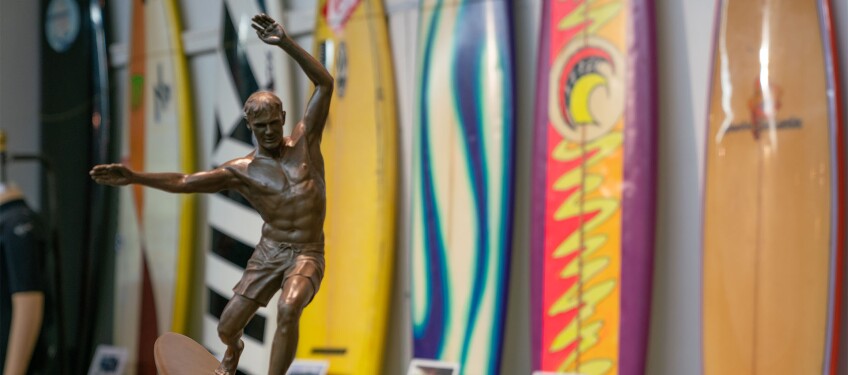Lost LA Field Notes: Surf’s Up!

Union Bank is a proud sponsor of Lost LA. 
Full disclosure: despite growing up in Orange County, California, I’ve never surfed. And to be perfectly honest, before we made this “Beach Culture” episode of Lost LA, I didn’t realize how far surfing’s influence extended — to my own childhood, it turns out.
As a child, I’d spend hours playing in the waves on my family’s weekly trips to Corona del Mar State Beach. To me, nothing felt more natural. Yet, until surfers like Duke Kahanamoku and George Freeth came to Southern California from Hawaii in the early 20th century, few people ventured beyond ankle-deep water into the surf. Surfers, as historian Peter Westwick explains in the episode, invented modern lifeguarding techniques that made the beach safe for children like me. They also introduced comfortable beach wear that made playing in the waves more enjoyable. (Imagine body surfing in one of those heavy Victorian bathing suits!) Several times over the course of production, I thanked surfers for making those childhood adventures possible. And I resolved to (someday) learn to surf.
Meeting Dick Metz
In the making of this episode, I was — to borrow a word from surf slang — “stoked” to chat with Dick Metz, who shares his encyclopedic knowledge of the evolution of surfing and the surfboard. Dick lived the history he narrates in the episode, witnessing dramatic changes not only to surfing but, more generally, to beach culture and beach fashion.
In fact, we really could have made the episode just about him and his own personal journey.

Dick began surfing near Dana Point in the 1930s. His first board was made from solid redwood and weighed more than a hundred pounds. He rode waves with Duke Kahanamoku, perhaps the most legendary surfer of all time. He was a retail pioneer. Partnering with Hobie Alter, he opened the first retail surf shop on Oahu and later co-founded the Surf Line Hawaii clothing line that introduced Jams surf shorts to the world. And, most impressively, Dick’s globetrotting, hitchhiking surf adventure between 1958 and 1961 took him to breaks in South Africa, the South Pacific, and Australia — a three-year trek that inspired his friend Bruce Brown’s landmark 1966 film, “The Endless Summer.”
More recently, Dick got serious about preserving surf history and founded the Surfing Heritage & Culture Center in San Clemente. See “The Archive” section below for details.

Muscle Beach
If I mention Muscle Beach, you just might picture Arnold Schwarzenegger pumping iron next to the Venice boardwalk. But bodybuilding is only part of the story of Muscle Beach. An early cut of this episode highlighted the history of the original Muscle Beach in Santa Monica, which has long provided a home for acrobats, gymnasts, and Hollywood stunt performers. Unfortunately, that segment didn’t make the final cut, but I do encourage viewers to browse Steve Ford’s excellent Muscle Beach website for the full story behind both the Santa Monica and Venice editions of Muscle Beach.
Essential Reading
- “The World in the Curl: An Unconventional History of Surfing” by Peter Westwick and Peter Neushul (Crown Publishing, 2013)
The Archive
The Surfing Heritage & Culture Center in Orange County boasts one of world’s largest and most significant surfboard collections. Some one hundred artifacts are on display in the central museum space, and each narrates a piece of the story of surfing’s evolution through technological innovation. The center also maintains a research library with extensive archival collections, including more than 100,000 images and complete runs of major surf magazines. The center is open six days a week, Tuesday through Sunday.
Top Image: Displays at the Surfing Heritage & Culture Center | Katie Noonan













